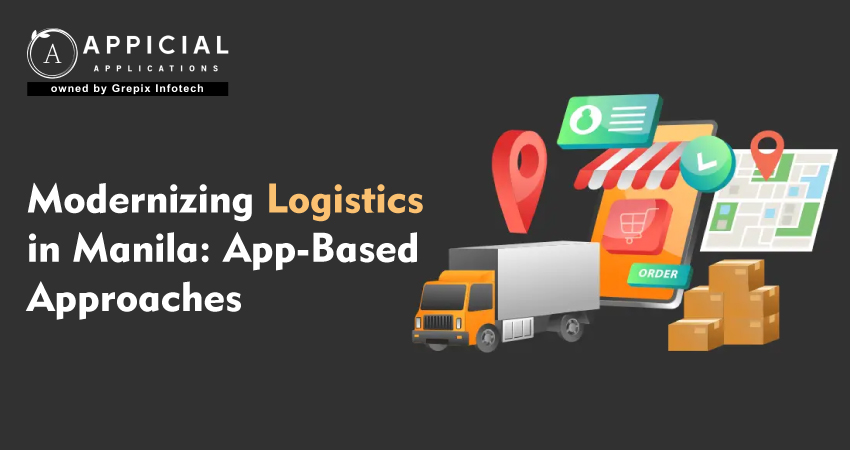
Modernizing Logistics in Manila: App-Based Approaches
Picture this.
It’s a Monday morning. You're running an online store in Quezon City. Orders are piling up. Your rider is stuck in traffic along C5. One customer keeps calling. Another is asking for an update through Facebook chat.
You open your spreadsheet. Try to match tracking numbers to drivers. It's a mess.
You sigh.
“This shouldn’t be this hard.”
If you run a logistics business or any company that relies on deliveries, you’ve probably been here. Every day feels like a race against time, traffic, and miscommunication.
So what’s the problem? Why is logistics in Manila still so behind?
Let’s take a closer look.
Manila’s logistics scene is chaotic, but change is coming fast. With mobile apps, businesses are finally finding smart ways to handle traffic, tracking, and delivery pain points. In this blog, we dive into the problems Manila faces, how mobile apps bring change, and what real companies are doing to win. We end with one of the most promising platforms helping the logistics industry grow, Appicial Applications.
What makes logistics in Manila so hard to manage?
Manila is growing. Fast. So are its challenges. Especially in logistics.
Here's what most businesses face every day:
- Traffic that eats time like a monster: Manila traffic is brutal. A trip that should take 20 minutes easily becomes two hours. This throws delivery schedules into chaos. And no, Waze can’t always help when the roads are packed everywhere.
- Old school systems still rule: Many companies still use manual tracking. Whiteboards. Paper receipts. Phone calls to confirm deliveries. One missed step? And things spiral.
- Costs keep going up: More time on the road means more fuel burned. More labor hours. More complaints. And yes, more lost money.
- Small businesses don’t have access to better tools: Big companies have their fancy systems. But for the smaller players? Most just try to survive. No apps. No dashboards. Just hopes and prayers.
- Customers left in the dark: People want updates. But with manual systems, updates take time. Or worse, never come at all. Customers grow anxious. Trust fades.
So what’s the fix?
Can a mobile app really change the game in Manila’s delivery scene?
Now imagine something different.
You open your phone.
- You see your rider's exact location.
- Your customer gets an SMS:"Your package is 10 minutes away."
No calls. No panic. No guesswork.
This is what a Manila logistics app can do.
And it’s already happening.
Let’s break down what mobile solutions bring to the table.
What are the real benefits of using a mobile logistics app in Manila?
- See everything, right now: Mobile apps give you real time tracking. You know where your drivers are. You can reroute them on the fly. Your customer? They can see their package on the way. Like food delivery, only now, it’s for everything.
- Smarter routes, faster trips: Mobile apps calculate the best route using live traffic data. That saves time and fuel. A delivery that used to take 2 hours? Now it's 45 minutes.
- No more paper, no more confusion: Everything is recorded. Drivers log deliveries with one tap. Customers can sign digitally. You save time, and reduce mistakes.
- Even small businesses can join the big leagues: No need for expensive systems. Just a phone. Apps make powerful tools simple to use, even for a one man delivery team.
- Know what’s working and what’s not: Good apps show data:
- Which driver is fastest?
- What days are busiest?
- Where do delays happen?
You can make better decisions. Fix problems faster. Grow with confidence.
That’s why more logistics solutions in Manila are built with mobile in mind.
How do you even start using a mobile logistics app?
Sounds great, right?
But how do you start?
It’s simpler than you think. Here's what many companies in the supply chain Philippines are doing:
- Pick one pain point: Start small. Maybe you want real time tracking. Or maybe you just want to digitize delivery records. Focus on that first. No need to do everything overnight.
- Choose an app built for Manila: Manila’s roads are unique. So are its logistics problems. Look for an app that understands this. Local features matter: cash on delivery, barangay zones, odd traffic patterns.
- Train your team: The app only works if people use it. Make training easy. Keep it friendly. Some drivers may not be tech savvy, that’s okay. Start slow. Be patient.
- Connect it to your other tools: If you use an inventory system, link it. If not, no problem. Most apps can work as standalone tools. But integration saves even more time.
- Get feedback. Improve. Repeat.: Ask your team: What’s working? What’s hard? Most apps release updates regularly. Stay involved. Keep growing.
Also Read: Jakarta’s Logistics Evolution: The Impact of Mobile Apps
Who’s already winning with logistics apps in Manila?
Let’s look at real stories from real businesses using mobile logistics tools in the city.
- A small courier team turns pro: Joey started a courier business in Mandaluyong with three riders. At first, they used notebooks to track deliveries. Packages got mixed up. Drivers got lost. Customers were upset. He tried a Manila logistics app with GPS and proof of delivery tools. Three months in: They reduced missed deliveries by 80%. Fuel use dropped by 25%. Joey expanded to six more riders. Now he’s not just running a courier service. He’s building a brand.
- A Pasig furniture seller fixes delivery chaos: Ana sells custom furniture online. Her biggest problem? Late deliveries. Her bulky pieces needed careful handling. But drivers often showed up late, or not at all. After switching to an app that allowed scheduling and real time tracking, things changed. She started sending ETAs to customers. Suddenly, complaints turned into 5 star reviews. And referrals came flying in.
- A farmer co op reaches Manila without losing produce: A cooperative in Laguna used to deliver fresh vegetables to Metro Manila. But without tracking, delays and spoiled goods. They adopted a supply chain Philippines app. Now they schedule pickups, monitor routes, and alert supermarkets in advance. The result? 90% of their produce now arrives fresh. Partner stores increased their orders. Farmers earn more, and waste less.
These are not tech giants. Just everyday businesses using the right tool at the right time.
What’s next for logistics in the Philippines?
The city’s growing. So is demand. If you’re in logistics, one thing’s clear, manual methods won’t cut it anymore.
Mobile apps bring clarity to chaos.
- They help you deliver faster.
- They build trust with your customers.
- They save you money.
This shift is happening now. You don’t need to wait. You don’t need to be big. You just need the right tool.
Where should you start? Try Appicial Applications.
If you’re looking for a reliable, user friendly, and locally aware solution, start with Appicial Applications.
They specialize in logistics solutions Manila needs most, designed for real roads, real riders, and real businesses.
Whether you run a courier team, manage a fleet, or operate a growing eCommerce store, Appicial helps you:
- Track deliveries live
- Plan efficient routes
- Collect proof of delivery
- Reduce manual work
- Serve customers better
Their platform is built with simplicity in mind. You don’t need a full tech team. Just a smartphone and a goal to do better.
Appicial isn’t just another software company. They’re partners to businesses looking to modernize, without the headaches.
So if you’re ready to take your logistics to the next level, start here. Try Appicial Applications. Make deliveries smoother. Make customers happier. Make business easier.
Final thought?
In conclusion, taxi apps are revolutionizing urban commutes in 2025, offering a smarter, safer, and more seamless transportation experience. With features like real time tracking, cashless payments, and dynamic pricing, these digital platforms are addressing long standing urban mobility issues reducing wait times, easing congestion, and promoting eco friendly travel. Cities across the globe are witnessing this shift, where traditional taxi services are rapidly giving way to app-based ride-hailing ecosystems.
At the forefront of this transformation is Appicial Applications, a leading logistics app development company specializing in custom taxi app solutions. With years of expertise and a portfolio of successful deployments in over 50 countries, Appicial delivers end to end ride-hailing platforms tailored to urban mobility challenges. Whether you're a startup entering the ride-hailing market or an established business looking to scale, Appicial’s white-label taxi app solutions provide everything from advanced user interfaces to driver management and admin control.
As the demand for smarter transportation grows, partnering with a trusted technology provider becomes essential. Appicial Applications not only empowers businesses to launch feature-rich taxi apps swiftly but also ensures ongoing support, scalability, and innovation. In the evolving landscape of urban mobility, Appicial stands out as a reliable partner helping shape the future of commuting.
Modern logistics isn’t about doing more.
It’s about doing smarter.
And with the right app, that future starts today.
Let me know if you'd like help integrating Appicial into your business,or if you need a step by step setup guide.
Looking out to start your own Logistics venture? Try out our GTA Logistics app, the easiest way to kick-start your logistics business.Author's Bio

Vinay Jain is the Founder at Grepix Infotech and brings over 12 years of entrepreneurial experience. His focus revolves around software & business development and customer satisfaction.
Back to blog list




